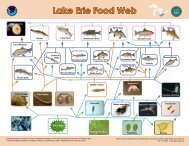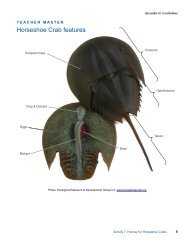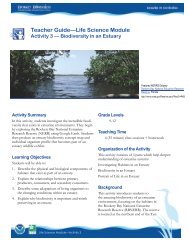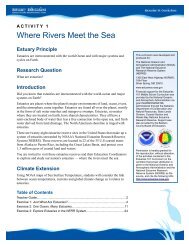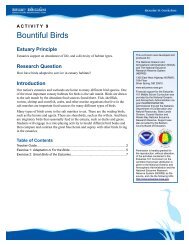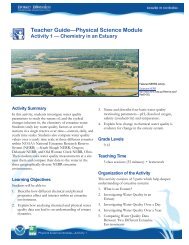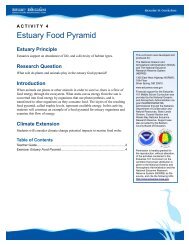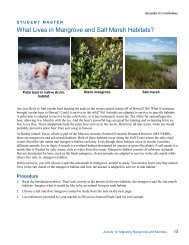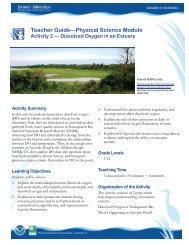The Great Oyster Mystery Teacher Guide - Estuaries NOAA
The Great Oyster Mystery Teacher Guide - Estuaries NOAA
The Great Oyster Mystery Teacher Guide - Estuaries NOAA
You also want an ePaper? Increase the reach of your titles
YUMPU automatically turns print PDFs into web optimized ePapers that Google loves.
E X E R C I S E 3Cracking the Case with DataEstuary ConceptA better understanding of estuarine processes can be identified when abiotic andbiotic conditions are examined.Focus Questions• What caused the changes in young oyster abundance during 2007 and 2008 inAransas and Copano bays?Performance TasksStudents will:• Analyze real data to explain variations in water salinity and abundance ofoysters and oyster parasites/predators within Aransas and Copano bays.<strong>Teacher</strong> BackgroundIn order to answer the research question: “What caused the changes in youngoyster abundance during 2007 and 2008 in Aransas and Copano bays?” studentswill need to examine the team-collected salinity and precipitation data fromSWMP. <strong>The</strong>y will also explore the types of enemies that attack oysters. One suchenemy is the single-celled protozoan, Perkinsus marinus, a parasite that causesdermo disease in oysters. Other oyster enemies are the predators, oyster drills andstone crabs.OverviewIn this activity, students areasked to solve an <strong>Oyster</strong><strong>Mystery</strong>. In this last of threeexercises, students are askedto analyze the data they havegathered in the first twoexercises. <strong>The</strong>y are also askedto consider the impact of oysterenemies (parasites andpredators) on oysterpopulations and whether or notthose oyster enemies are alsoaffected by the same abioticfactors (e.g., salinity) as theoysters themselves.Time RequiredTwo 45-minute class periodsFirst, it is important to understand that the oysters live in bays found within theMission-Aransas Estuary. In order to thrive in these locations — and estuaries ingeneral — oysters must live within certain environmental ranges that containupper and lower limits. As an example, oysters thrive best within a salinity rangeof 14 to 28 parts per thousand (ppt.). If oysters are in water outside of this rangeat either end for too long, they will not thrive. At extreme levels outside of thisrange, the oysters will die.Next, it is important to realize that the salinity of the water within the estuarydoes not always stay the same. Salinity is a measure of the amount of dissolvedsalts in water. In the open ocean, salinity varies little. Salinity in an estuary,however, varies according to location, tidal fluctuations, and the volume offreshwater entering the estuary, either via runoff or directly via precipitation.Overall salinity levels in many estuaries decline in the spring, when snowmeltand spring rains produce elevated freshwater flows from streams and groundwater. <strong>The</strong> added fresh water “dilutes” the water in the estuary, lowering salinitylevels. In the Mission-Aransas Estuary, salinity is more likely to be lowered bylarge storms that send enormous surges of fresh water down into the bays via theAransas and Mission rivers.<strong>Oyster</strong>s are not the only organism with a salinity tolerance range. <strong>The</strong> protozoanthat causes dermo disease has a salinity tolerance range. So do the oysterpredators, the oyster drill and the stone crab. All of these organisms, oystersActivity 11: <strong>The</strong> <strong>Great</strong> <strong>Oyster</strong> <strong>Mystery</strong> 15



